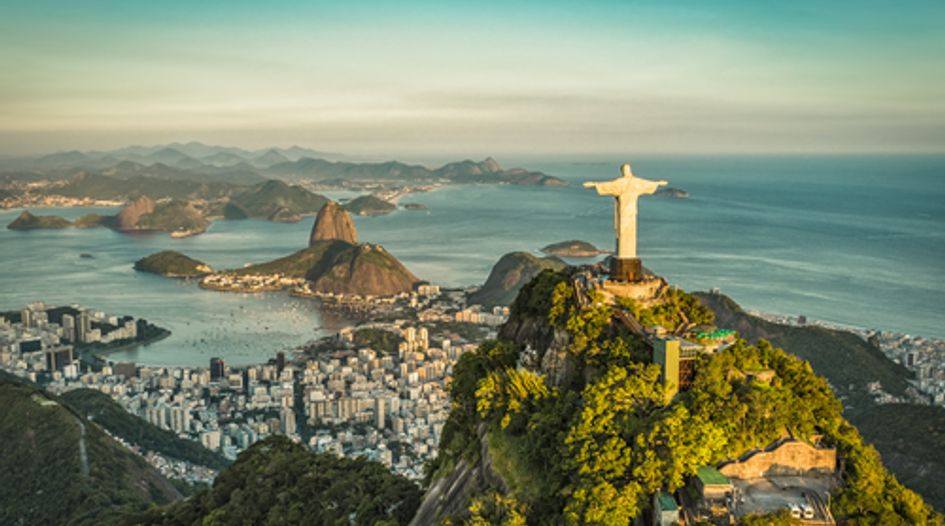Brazil: new National Plan to Combat Piracy is encouraging news for rights holders

This is an Insight article, written by a selected partner as part of WTR's co-published content. Read more on Insight
Legal framework
The growth of the Brazilian market and economy is paralleled by the increase in counterfeiting activities. The enforcement of IP rights involves planning, technology, intelligence, training and coordination, with support from a number of laws and treaties, as well as the relevant rules of the Federal Constitution, the Civil Code, the Criminal Code, the Civil Procedure Code, the Criminal Procedure Code and administrative statutory instruments.
The legal framework for anti-counterfeiting includes:
- the Industrial Property Law (9,279/96);
- the Copyright Law (9,610/98);
- the Software Law (9,609/98); and
- the Internet Law (12,965/14).
In addition, Brazil is a signatory to the main international IP instruments, such as:
- the Paris Convention for the Protection of Industrial Property (as revised in Stockholm in 1967);
- the Agreement on Trade-Related Aspects of Intellectual Property Rights (TRIPs);
- the Berne Convention for the Protection of Literary and Artistic Works;
- the Washington Copyright Convention;
- the Universal Copyright Convention;
- the Rome Convention for the Protection of Performers, Producers of Phonograms and Broadcasting Organisations; and
- the Geneva Convention for the Protection of Producers of Phonograms against Unauthorised Duplication of their Phonograms.
With regard to trademark and copyright practice, the following acts are considered violations of IP rights in both the civil and criminal spheres:
- trademark infringement;
- geographical indication infringement;
- unfair competition practices; and
- copyright and software violations.
Enforcement provisions allow rights holders to take civil action to prevent further infringement and to recover losses incurred from actual infringement and criminal actions, with a view to convicting the infringers and imposing the penalties established by law. However, in practice, prison sentences are not imposed on counterfeiters.
Lawsuits are usually heard by state courts, while the federal courts hear actions seeking to declare void an IP right issued by the Brazilian Patent and Trademark Office (BPTO).
In Brazil, the rights holder, the licensee and some associations (eg, copyright collecting associations) have legal standing to bring civil lawsuits for IP infringement.
Border measures
The following statutory instruments regulate border measures in Brazil:
- Article 198 of the Industrial Property Law;
- Articles 605 to 608 and 803 of the Customs Regulatory Act (Federal Decree 6,759/09);
- TRIPs; and
- certain other laws and rules.
Such regulations set forth the general guidelines for inspecting and retaining merchandise suspected of being counterfeit and establish the administrative procedures for final seizure and destruction.
Due to the great extent of the country’s borders, imported merchandise is monitored by Customs through sampling processes.
Retentions are made ex officio or on the rights holder’s request when there is prima facie evidence of violation. Thus, customs officers can hold for inquiry goods that are suspected of infringing trademarks and copyrights. Once the merchandise has been held, the rights holder or its trademark attorney is contacted to collect samples and state, by means of a formal declaration and within 10 business days, whether the goods are genuine. If they are genuine, the products are released to the importer.
If the goods are suspected of being counterfeit, in most states the rights holder can choose between the customs administrative procedure to suspend release of the goods or a judicial remedy. In the first case, a complaint based on a technical report must be presented before Customs, requesting the definitive seizure and destruction of the goods, and the importer is notified to reply. In the second case, the rights holder seeks to obtain a preliminary injunction requiring Customs to disclose the name and address of the importer – since this data is treated by the authorities as privileged and covered by tax privacy – and then files a lawsuit against the importer, requesting the seizure and destruction of the infringing merchandise. The importer is summoned to reply.
Some customs agencies interpret the law to mean that judicial action is mandatory and they release the goods if it is not commenced.
After a considerable delay, in December 2013 the BPTO launched the National Trademark Owners Directory. The directory is a central database where authorities engaged in combating piracy (eg, the police, Customs and federal prosecutors) can access detailed information on trademarks that are targets for counterfeiting activities. The database represents a breakthrough in the enforcement of trademark rights, helping an increasing number of rights holders to prevent counterfeiting and piracy effectively.
As established by the National Council for the Combat of Piracy Resolution 1/2011, the directory will assist public authorities in:
- obtaining samples, manuals and information on original products for the examination of seized counterfeiting goods by the police;
- obtaining complaints and documents for the purposes of filing a police investigation or filing a report on raids aimed at curbing trade in counterfeit goods;
- obtaining technical opinions concerning the authenticity of retained or seized goods by public authorities; and
- making decisions on the detention of suspected counterfeit goods.
Moreover, the Internal Revenue Service launched the Brand Representatives’ Contact List, a database that allows the customs authorities to contact the owner of the potentially infringed trademark. The project appears to overlap with the BPTO’s National Trademark Owners Database but is in fact another tool with which to fight counterfeiting activities.
A general request for surveillance can be filed at the Customs General Management Office, but rights holders can also express their concerns and ask customs officials directly to carry out inspection and monitoring, training them with regard to the features of their brands and products. Therefore, personal contact with and training of customs agents to identify infringing goods are possible and usually recommended.
Criminal prosecution
Lawsuits on the grounds of trademark infringement are prosecuted before state courts and through private criminal prosecution brought by the rights holder. However, most acts of copyright infringement (except for software infringement) are prosecuted before state courts by means of criminal actions, which are initiated by public authorities.
While the penalty for trademark infringement ranges from imprisonment of three months to one year or a fine, the penalties for copyright infringement (where the violation has economic consequences) may vary from imprisonment of two to four years and a fine.
Before a criminal prosecution for trademark infringement is initiated, the illegal activity must be proved. Thus, before filing a lawsuit seeking detention of the infringer, the rights holder must proceed with a preliminary criminal search and seizure action, where a court-appointed expert will seize and examine samples of the products. If infringement is confirmed, the expert’s opinion is homologated by the criminal judge and the rights holder will have 30 days to file the criminal action.
In cases of copyright infringement, the public authorities can initiate the public criminal action ex officio or at the request of the rights holder. In both cases, the copyright owner may participate in the action as assistant to the public prosecutor.
The law also grants enforcement authorities the discretionary power to conduct police raids against piracy and counterfeiting activities since they are regarded as criminal offences. Raids are usually conducted in city areas where many street peddlers or shops sell counterfeits and suspects are taken to the police station for testimony.
Following the seizure of merchandise in such raids, the products are analysed by police experts, a final report is prepared and the rights holder and/or the public authorities are required to file the subsequent criminal actions. Police and criminal actions are effective enforcement remedies in many circumstances and the equipment and machinery used for the counterfeiting activity can also be seized and destroyed. An advantage of police raids is that they can be conducted against many infringers simultaneously, and even against infringers that have not previously been identified.
Civil enforcement
The Industrial Property Law establishes that, independent of the criminal action, the aggrieved party may file a civil lawsuit, seeking interim injunctive relief and damages. Both the Industrial Property Law and the Civil Procedure Code allow the granting of ex parte preliminary restraining and/or search and seizure orders. To obtain injunctions of this nature, the following procedural requirements must be met by the rights holder:
- evidence of its right;
- substantial and unquestionable proof of infringement; and
- elements that may demonstrate a reasonable degree of risk of damage if the injunction is not granted.
In some enforcement circumstances, it is recommended to issue a cease and desist letter before going to court.
Regarding software violations, the Software Law sets out a specific procedure. Before a civil lawsuit for damages is filed, the software owner must file a preliminary inspection action with an injunction request. If granted, two court-appointed experts will inspect the computers, servers and related devices in the search for illegal licences. Thirty days later, the software holder must initiate a civil lawsuit for damages and, based on the contents of the court experts’ opinion, request an injunction for the defendant to be ordered to refrain from using the infringing software under penalty of a daily fine.
As regards copyright infringement, the Copyright Law compels the infringer to surrender to the rights holder all infringing copies that it still possesses and to pay for the remainder of the copies that it produced, at the price at which they were sold or would have been sold. It also states that if the number of illegal copies is unknown, the infringer must pay the value of 3,000 copies in addition to those seized.
The Brazilian legal framework also foresees other types of civil enforcement remedy for IP rights infringements. One procedure commonly used is the preliminary action for the early production of evidence, which is normally used in cases where the evidence of the infringement may disappear or be modified. Similarly to the procedure for software infringement, upon ratification of the court expert report, the rights holder must file the civil lawsuit for damages based on the contents of the court’s opinion. Finally, the violation of any IP right creates an obligation to pay damages. To this end, the Industrial Property Law rules that the damages will be calculated based on the most favourable criterion to the injured party, as follows:
- the benefits that would have been gained by the injured party if the violation had not occurred;
- the benefits gained by the party that violated the rights; or
- the remuneration that the violator would have paid to the rights holder for a licence that would have permitted it to exploit the rights legally.
Punitive damages can also be claimed, but are seldom granted.
The civil compensation procedures are often slow and time consuming, and their success depends on the evidence of damages, the circumstances and the defendant’s financial situation.
Anti-counterfeiting online
In 2014 the Congress enacted Law 12965/2014, known as the Brazilian Civil Rights Framework for the Internet. The law aims to establish principles, guarantees, rights and obligations concerning the use of the Internet in Brazil, as well as to provide guidelines for the public administration on the matter.
Brazil has no specific statute dealing exclusively with online IP infringement, but the legal framework – including the Internet Law – provides an enforcement system against online counterfeiting activities. Case law dealing with online infringement states that Brazil has jurisdiction over disputes arising from facts occurring or having effect within Brazilian borders. Online infringements are litigated before civil and criminal state courts. Only IP rights validity claims and specific international online infringements fall under federal jurisdiction and must be litigated before a federal court.
The complaint must present evidence of the infringed right, the facts and the connection between these and the defendant (eg, website administrator or internet service provider (ISP). Identification of the party that is responsible for the alleged infringement, although not mandatory, is recommended and usually required to bring effectiveness to any judicial decision.
Previous decisions established the ISP’s responsibility regarding the information available on websites, especially if the ISP fails to respond or provide a remedy after receiving a first notice from the rights holder. However, in these cases the Internet Law has been addressed on multiple occasions since its enactment in 2014, including in third-instance (ie, final) decisions. The Internet Law’s most important provisions are found in its first chapter, which establishes its foundations, principles, objectives and concepts. Besides providing for the rights and guarantees of internet users, the network’s neutrality and security and the role of public authorities, the act establishes guidelines and an enforcement system for the liability of ISPs, using criteria that are dependent on the ISP category (ie, whether it is a backbone, email, access, application or content provider).
Essentially, the choice of an application provider not to keep records of access to an internet application does not imply its liability for damages arising from the use of these services by third parties (Article 17), and the provider of an internet connection is not liable for civil damages resulting from content generated by third parties (Article 18). As far as anti-counterfeiting measures are concerned, the most important change introduced by this act is that the Brazilian system has moved from a ‘notice and takedown’ regime to a ‘judicial injunction decision and takedown’ regime. Under the new regime, a provider of internet applications can be subject to civil liability resulting from content generated by third parties only if, after a court order, it does not take any steps to make the infringing content unavailable within the ordered framework and time (Article 19). However, this provision does not apply to the infringement of copyright or related rights.
The Brazilian domain name registration authority adopted an alternative dispute resolution proceeding for all ‘.br’ domain names registered from October 2010 onwards. This proceeding is similar to international mechanisms – its rules are based on the UDRP – and aims to reduce time and costs and lead to effective domain name protection.
Preventive measures/strategies
Besides registering trademarks, certain preventive measures should be taken to enhance the chances of success of an anti-counterfeiting campaign.
Under Brazilian law, the use of local legal counsel is mandatory when a complaint is filed before the courts. The chosen counsel should be experienced in IP matters, as well as civil, police and customs remedies. The use of investigators is important, as in Brazil the burden of proving the infringement lies with the plaintiff in both criminal and civil cases and the defendant is always entitled to withhold from the plaintiff any self-incriminatory evidence.
It is also vital that certain precautions be taken by the rights holder in its relationship with third parties (eg, licensees, local manufacturers or distributors). Due to the information and the materials that they receive, these companies will be in a unique position to infringe the IP right(s) should they wish to do so. Therefore, it is highly recommended to select local partners carefully to deal only with local businesspeople with a strong ethical background, and to initiate the business relationship only after a proper contract has been executed, which includes all basic clauses for the protection of the IP right and the rights holder.
Whenever possible, the use of authentication technology (eg, security labels and authentication checking devices) to fight counterfeiting is helpful, and investment in these new technologies is increasing in Brazil. Continuous monitoring of possible counterfeiters is a basic necessity, and sellers of the original goods should be taught how to identify counterfeit goods, receive incentives to do so, report infringements and receive feedback.
The effectiveness of enforcement can be strengthened when multiple legal grounds (eg, false advertising, commercial fraud and offences under the Consumer Law) are combined.
Cooperation with official anti-counterfeiting agencies and financial services companies is indispensable to implement and maintain a successful anti-counterfeiting programme. Several agencies are responsible in this area, depending on the nature of trade (eg, Customs for imported goods and goods already in the Brazilian market, and in some states the specialist anti-piracy police) and the nature of goods (eg, the Brazilian Health Surveillance Agency for medicinal drugs). The dialogue with the competent authorities must not stop; if the rights holder so desires, such dialogue can be conducted through alliances or associations dedicated to fighting counterfeiting formed by companies with similar activities.
Finally, in December 2021, the Ministry of Justice and Public Security ratified the new National Plan to Combat Piracy (PNCP). The plan will have a duration of four years (2022–2025) and 62 goals to fight crime with short-, medium- and long-term actions.
Prepared by the National Council to Combat Piracy and Crimes Against Intellectual Property, the work will focus on combating digital piracy, but without neglecting piracy in physical locations. The PNCP is structured around four axes of action, which encompass all spheres of the problem: institutional, prevention and protection, training, and educational.
In the institutional axis – articulation actions between different bodies – will be prioritised, with discussions on the feasibility of installing specialized police precincts in the fight against piracy and violations of industrial property rights, as well as legislative improvements.
The second axis – prevention and protection – intends to put into practice projects that improve measures to repress infringements against intellectual property.
The third axis – training – includes training actions related to the fight against piracy and related crimes to public agents, with a focus on the exchange of information and good operational and investigation practices.
The damages that exist from an environmental and economic perspective to the country offered by pirated products will be addressed in the fourth axis – the educational axis. The objective is to show that the consumer who makes this purchase fuels drug and arms trafficking by criminal organisations, in addition to causing risks to their own health.







